细胞能量转换
初中生物知识点解析细胞的能量转换

初中生物知识点解析细胞的能量转换细胞是组成生物体的基本单位,它们通过各种生物化学反应来转换和利用能量。
细胞内的能量转换主要涉及到细胞呼吸和光合作用两个过程。
一、细胞呼吸细胞呼吸是细胞内产生能量的过程,它通过将有机物质(如葡萄糖)分解为二氧化碳和水释放出能量。
细胞呼吸可被分为三个阶段:糖解、解压和氧化磷酸化。
1. 糖解阶段:糖类物质在胞质中经过一系列酶催化的反应分解成糖酵解产物。
其中最常见的糖酵解产物是丙酮酸和磷酸甘油酸。
2. 解压阶段:丙酮酸进入线粒体,并在线粒体内发生一系列的反应,最终生成丙酮酸脱羧酶能够利用的物质——辅酶A。
磷酸甘油酸也进入线粒体,分解为乙醛和二磷酸甘油。
3. 氧化磷酸化阶段:辅酶A进入Krebs循环(或称三羧酸循环),在此过程中进一步氧化,生成能够供细胞利用的能量(ATP)、二氧化碳和水。
ATP是细胞内的能量分子,它可以提供给细胞进行各种生物活动。
二、光合作用光合作用是植物细胞中的过程,通过光能转化为化学能。
光合作用主要发生在叶绿体内,包括光能捕获、光化学反应和暗反应三个阶段。
1. 光能捕获:叶绿体内的叶绿素能够吸收太阳光中的能量,光能激发叶绿素中电子的跃迁。
激发后的电子通过电子传递链传递至反应中心。
2. 光化学反应:在反应中心中,激发后的电子与光化学反应中心上的另一个电子结合,形成高能态的电子对。
接着,这对电子进一步传递至光化学反应链中。
3. 暗反应:光合作用的最后一个阶段是暗反应,也被称为Calvin循环。
在暗反应中,二氧化碳利用ATP和NADPH还原,产生出葡萄糖。
综上所述,细胞的能量转换主要涉及到细胞呼吸和光合作用两个过程。
细胞呼吸将有机物质分解为二氧化碳和水,释放出能量,而光合作用则将光能转化为化学能,通过暗反应生成葡萄糖。
这些过程为细胞提供了所需的能量,使细胞能够进行各种生物活动。
细胞的能量转换
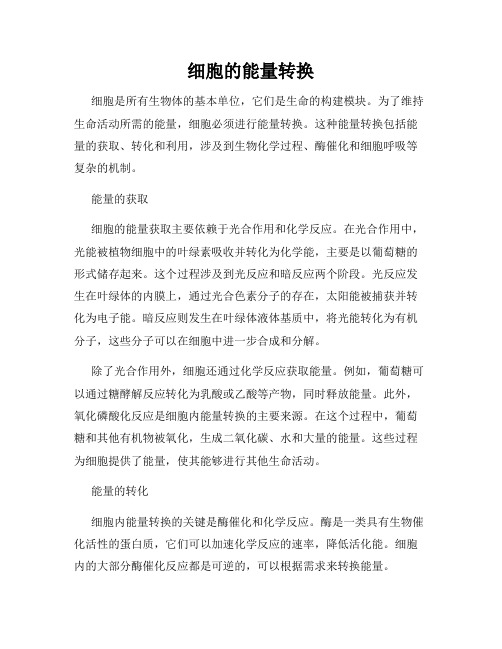
细胞的能量转换细胞是所有生物体的基本单位,它们是生命的构建模块。
为了维持生命活动所需的能量,细胞必须进行能量转换。
这种能量转换包括能量的获取、转化和利用,涉及到生物化学过程、酶催化和细胞呼吸等复杂的机制。
能量的获取细胞的能量获取主要依赖于光合作用和化学反应。
在光合作用中,光能被植物细胞中的叶绿素吸收并转化为化学能,主要是以葡萄糖的形式储存起来。
这个过程涉及到光反应和暗反应两个阶段。
光反应发生在叶绿体的内膜上,通过光合色素分子的存在,太阳能被捕获并转化为电子能。
暗反应则发生在叶绿体液体基质中,将光能转化为有机分子,这些分子可以在细胞中进一步合成和分解。
除了光合作用外,细胞还通过化学反应获取能量。
例如,葡萄糖可以通过糖酵解反应转化为乳酸或乙酸等产物,同时释放能量。
此外,氧化磷酸化反应是细胞内能量转换的主要来源。
在这个过程中,葡萄糖和其他有机物被氧化,生成二氧化碳、水和大量的能量。
这些过程为细胞提供了能量,使其能够进行其他生命活动。
能量的转化细胞内能量转换的关键是酶催化和化学反应。
酶是一类具有生物催化活性的蛋白质,它们可以加速化学反应的速率,降低活化能。
细胞内的大部分酶催化反应都是可逆的,可以根据需求来转换能量。
酶催化反应通过底物与酶的结合形成复合物,然后在活化能最低的路径上发生化学反应。
这些反应可以将底物转化为产物,也可以将产物反向转化为底物。
通过调节酶的活性和底物浓度,细胞可以控制能量的转化速率,满足其生理需要。
能量的利用细胞利用能量进行多种生物过程,如维持细胞结构、合成生物大分子、运输物质和细胞分裂等。
这些生物过程依赖于细胞内的能量转化和能量释放。
细胞内能量的利用主要是通过细胞呼吸来实现的。
细胞呼吸分为三个阶段:糖酵解、三羧酸循环和氧化磷酸化。
糖酵解将葡萄糖分解为乳酸或乙酸,并产生少量的ATP。
三羧酸循环将乙酸等有机酸转化为二氧化碳,同时生成较多的ATP和还原剂。
氧化磷酸化则是细胞内能量转化的最终步骤,在线粒体的内膜上进行。
细胞的能量转换与代谢

细胞的能量转换与代谢细胞是构成生物体的基本单位,它们通过能量转换和代谢过程维持着生命的各种活动。
细胞内能量的转换主要通过三种方式实现:细胞呼吸作用、光合作用和发酵作用。
这些过程相互关联,为细胞提供所需的能量和物质。
【引言】细胞是生物体的基本单位,维持着生命的各种活动。
细胞通过能量转换和代谢过程,将化学能转化为其它形式的能量,从而驱动生物体的生命活动。
本文将就细胞的能量转换和代谢过程进行详细阐述。
【主体部分】一、细胞呼吸作用细胞呼吸作用是细胞内最重要的能量转换过程之一,它将有机物(如葡萄糖)分解为二氧化碳和水,释放出大量的能量。
细胞呼吸作用包括三个阶段:糖解、Krebs循环和氧化磷酸化。
在糖解过程中,葡萄糖分解为两分子丙酮酸,生成ATP和还原剂。
接下来,丙酮酸通过Krebs循环进一步氧化,产生ATP和电子载体NADH和FADH2。
最后,通过氧化磷酸化,NADH和FADH2的电子通过呼吸链传递,与氧气结合生成水,释放出大量的能量。
二、光合作用光合作用是细胞内的能量转换过程,它将阳光能转化为化学能,并将二氧化碳和水转化为有机物。
光合作用主要发生在绿色植物的叶绿体中。
光合作用可以分为两个阶段:光反应和暗反应。
在光反应中,光能被光合色素吸收,产生ATP和还原剂NADPH。
在暗反应中,ATP和NADPH被利用,将CO2固定为有机物,并最终生成葡萄糖。
光合作用是地球上大部分生物的能量来源,同时还能产生氧气。
三、发酵作用细胞在无氧条件下(无氧呼吸或缺氧情况下)通过发酵作用进行能量转换。
发酵作用通过部分氧化有机物产生能量,无需氧气。
常见的发酵作用有乳酸发酵和酒精发酵。
乳酸发酵是一种无氧呼吸,葡萄糖通过糖酵解生成乳酸,产生少量的ATP。
酒精发酵是葡萄糖分解为乙醇和二氧化碳,同样也产生少量的ATP。
四、能量转换与代谢的关系细胞的能量转换与代谢密切相关。
能量转换提供细胞进行代谢所需的能量,而代谢过程则为能量转换提供所需的物质基础。
《高中生物课件:细胞的能量转换》

通过本课件,我们将一起探索细胞的能量转换过程,了解细胞是生命体系的 基本单位,以及不同能量转换途径的原理和应用。
细胞的能量来源和能量转换
光合作用
细胞通过光合作用将太阳 能转化为化学能,进而供 给生物体生命活动。
无氧呼吸
在缺氧条件下,细胞通过 无
动物通过摄食植物或其他动物 来获取能量,维持生命活动。
分解者
分解者以死亡有机物为食,将 有机物分解成无机物,促进循 环。
生物体内的能量守恒与转化
生物体内能量守恒,细胞通过能量转化将一种形式的能量转化为另一种形式, 并在各个层级上维持能量流动和物质循环,实现生命活动。
能量转换在生态系统中的作用
有氧呼吸
在氧气存在的条件下,细 胞通过有氧呼吸进行高效 能量转换。
光合作用的原理及过程
光合作用是指植物细胞中通过叶绿体将太阳能转化为化学能的过程。它包含 光反应和暗反应两个阶段,通过光合色素吸收光能,产生ATP和NADPH,并进 一步合成有机物质。
光合作用的反应方程式
光合作用的反应方程式可表示为:光能 + 6 CO2 + 12 H2O → C6H12O6 + 6 O2 + 6 H2O。
1 维持生态平衡
能量转换维持着生态系统的 稳定,保障生物间的相互依 存和平衡。
2 推动物种演化
能量转换对物种的适应和进 化起到重要推动作用。
3 影响生态链
能量转换的变化会对食物链和群落结构产生影响。
人类能源的利用与供给
人类利用化石燃料和可再生能源等能源供给生产和生活需求,但同时也需要考虑环境保护和可持续发展 的问题。
其他能量转换途径
1
有氧呼吸
细胞的能量转换与物质运输知识点总结
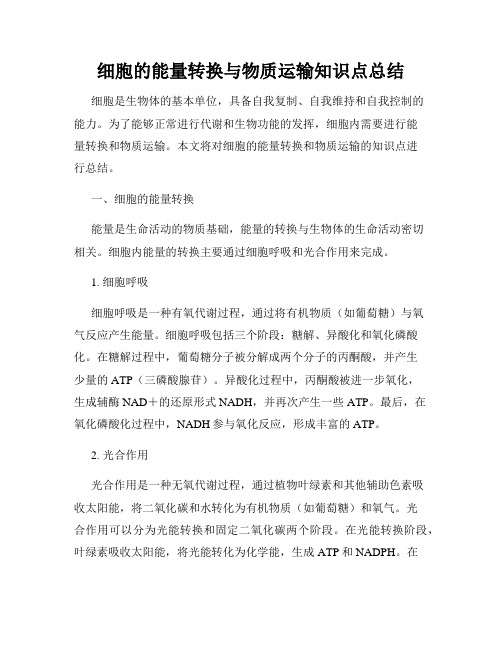
细胞的能量转换与物质运输知识点总结细胞是生物体的基本单位,具备自我复制、自我维持和自我控制的能力。
为了能够正常进行代谢和生物功能的发挥,细胞内需要进行能量转换和物质运输。
本文将对细胞的能量转换和物质运输的知识点进行总结。
一、细胞的能量转换能量是生命活动的物质基础,能量的转换与生物体的生命活动密切相关。
细胞内能量的转换主要通过细胞呼吸和光合作用来完成。
1. 细胞呼吸细胞呼吸是一种有氧代谢过程,通过将有机物质(如葡萄糖)与氧气反应产生能量。
细胞呼吸包括三个阶段:糖解、异酸化和氧化磷酸化。
在糖解过程中,葡萄糖分子被分解成两个分子的丙酮酸,并产生少量的ATP(三磷酸腺苷)。
异酸化过程中,丙酮酸被进一步氧化,生成辅酶NAD+的还原形式NADH,并再次产生一些ATP。
最后,在氧化磷酸化过程中,NADH参与氧化反应,形成丰富的ATP。
2. 光合作用光合作用是一种无氧代谢过程,通过植物叶绿素和其他辅助色素吸收太阳能,将二氧化碳和水转化为有机物质(如葡萄糖)和氧气。
光合作用可以分为光能转换和固定二氧化碳两个阶段。
在光能转换阶段,叶绿素吸收太阳能,将光能转化为化学能,生成ATP和NADPH。
在固定二氧化碳阶段,ATP和NADPH参与到卡尔文循环中,最终产生有机物质。
二、细胞的物质运输细胞内外的物质运输对于细胞内环境的维持和功能发挥至关重要。
细胞的物质运输主要通过细胞膜的渗透、扩散和主动运输等方式进行。
1. 渗透渗透是指溶液通过半透膜扩散到溶液浓度低的一侧,以使两侧溶液浓度趋于均匀的过程。
渗透可以分为渗透和渗透压。
渗透过程中,水分子从纯水或低浓度溶液移动到高浓度溶液,以体现浓度差。
渗透压是溶液浓度对水分子渗透性的描述,高浓度溶液具有较高的渗透压,低浓度溶液则具有较低的渗透压。
2. 扩散扩散是指溶质从浓度高的区域沿着浓度梯度向浓度低的区域传播的过程。
扩散可以是无选择性的,即溶质沿浓度梯度自由传播;也可以是选择性的,即通过特定的载体蛋白进行传输。
细胞的能量转换

细胞的能量转换细胞是生物体内最基本的结构和功能单位,它们以精确的方式进行各种活动,以维持生物体的正常运作。
其中,能量在细胞内的转换起着至关重要的作用。
本文将探讨细胞内能量转换的过程,并介绍与之相关的重要分子和机制。
1. 能量转换的基本过程细胞内能量转换的基本过程是通过细胞呼吸进行的。
细胞呼吸是指细胞利用有机分子(如葡萄糖)和氧气产生能量的过程。
它包括三个主要阶段:糖解、Krebs循环和氧化磷酸化。
1.1 糖解糖解是指有机物分解为更小的分子,并产生能量。
在细胞内,葡萄糖通过糖酵解途径分解为两个分子的丙酮酸,同时产生一定量的ATP (三磷酸腺苷)。
糖解是细胞能量转换的起始阶段。
1.2 Krebs循环Krebs循环是细胞呼吸过程中的关键步骤。
在Krebs循环中,丙酮酸被进一步代谢,产生二氧化碳和电子供体NADH(烟酸腺嘌呤二核苷酸)。
这些释放的电子被转移到细胞色素系统。
1.3 氧化磷酸化氧化磷酸化是细胞呼吸的最后一个阶段。
在这个过程中,NADH和另一个电子供体FADH2(呋喃腺嘌呤二核苷酸)释放的电子通过线粒体内的电子传递链,最终被氧气接受。
这个过程产生的能量用于合成ATP。
2. 重要分子和机制与细胞的能量转换密切相关的分子和机制有许多。
2.1 ATPATP是细胞内主要的能量供应分子。
它是由三个磷酸基团和一个腺嘌呤核苷酸组成。
在细胞内,ATP通过释放磷酸基团的方式提供能量,这个过程称为ATP酶。
2.2 NADH和FADH2NADH和FADH2是电子供体,在细胞呼吸中起着至关重要的作用。
它们可以在糖解和Krebs循环中捕获释放的电子,并将其转移到线粒体内的电子传递链。
2.3 线粒体线粒体是细胞中的能量中心,它以其形状和结构功能特异性而闻名。
线粒体内的电子传递链是细胞中能量转换的关键部分。
通过电子传递链,线粒体将NADH和FADH2提供的电子转移到氧气上,同时释放能量。
3. 能量转换的重要性细胞内能量转换的过程对生物体的正常运作至关重要。
细胞生物学_06细胞的能量转换

⒊氧化磷酸化作用与电子传递的偶联
当电子从NADH或FADH2经呼吸链传递给氧形
成水时,同时伴有ADP磷酸化形成ATP,这一过
程称为氧化磷酸化。
NADH呼吸链生成ATP的3个部位是:①NADH 至辅酶Q;②细胞色素b至细胞色素c;③细胞色 素aa3至氧之间。但FADH2呼吸链只生成2个ATP 分子。
三、线粒体的功能
线粒体的主要功能是进行氧化磷酸化,合成 ATP,为细胞生命活动提供直接能量。 线粒体是糖、脂肪、和氨基酸最终释能的场所。 糖和脂肪等营养物质在细胞质中经过酵解作用
产生丙酮酸和脂肪酸。这些物质选择性地从细胞质
进入线粒体基质中,经过一系列分解代谢形成乙酰
CoA,即可进入三羧酸循环。
三羧酸循环脱下来的氢经线粒体内膜上的电子 传递链(呼吸链),最后传递给氧,生成水。
其意义:提供了氧化反 应所需的氢离子,通过 递氢体NAD+ 、 FAD将其 传递到呼吸链→氧化磷 酸化 。
-酮戊二酸 NADH2 2 NAD
NADH2
三羧酸循环开始。 总反应式:
2乙酰辅酶A+6NAD++2FAD++2ADP+2Pi+6H2O
4CO2+6NADH+6H++2FADH2+2辅酶A+2ATP
糖酵解
在细胞质中, 脂肪和葡萄糖 降解生成丙酮 酸进入线粒体 基质
三羧酸循环
在线粒体基质中,在丙酮脱氢酶体系作用下,丙酮酸进 一步分解为乙酰辅 酶A,NAD+作为受氢体被还原。 丙酮酸+辅酶A+2NAD+ 2乙酰辅酶A+CO2+2NADH+2H+ 乙酰辅酶A与草酰乙酸结合生成柠檬酸
细胞的能量转换

细胞的能量转换细胞是生命的基本单位,它们通过一系列复杂的生物化学反应将外界能量转化为可利用的形式,以维持生物体的正常功能和生存。
这个过程被称为细胞的能量转换。
本文将重点介绍细胞的能量转换过程及其相关机制。
一、葡萄糖的降解细胞的能量转换主要通过葡萄糖的降解过程来实现。
葡萄糖是一种重要的有机分子,是细胞内能量转换的主要燃料。
它被细胞摄入后,经过一系列酶催化的反应,逐渐分解为较小的分子,并释放出能量。
1. 糖酵解在细胞质中,葡萄糖分子通过一系列酶催化的反应,先被分解为两个分子的丙酮酸,再经过一系列的氧化和磷酸化反应,最终产生三个分子的丙酮酸、一分子的ATP(三磷酸腺苷)和NADH(辅酶还原型)等产物。
这个过程称为糖酵解,是葡萄糖降解的第一阶段。
2. 细胞色素的氧化磷酸化丙酮酸进一步进入线粒体的中间膜,通过一系列反应最终转化为辅酶A、NADH和FADH2等物质。
这些物质进入线粒体内膜的呼吸链,与氧气反应,产生大量的ATP。
这个过程被称为细胞色素的氧化磷酸化,是葡萄糖降解的第二阶段。
二、细胞色素系统细胞色素系统是细胞内负责电子传递和氢离子泵送的复合体。
它由多个色素分子和蛋白质组成,位于线粒体内膜上。
细胞色素系统通过接受NADH和FADH2释放的电子,以及利用这些电子的能量泵送氢离子,从而建立质子梯度。
这个梯度被用来合成ATP。
三、三磷酸腺苷(ATP)合成ATP合成是细胞的能量转换过程的最终阶段。
它发生在线粒体内膜上的ATP合酶上,通过质子梯度的驱动,将ADP(二磷酸腺苷)和一个无机磷酸根(Pi)结合成ATP。
这个过程被称为氧化磷酸化。
四、其他能量转换途径除了葡萄糖降解过程所产生的能量转换外,细胞还可以通过其他途径获得能量。
例如,脂肪酸的代谢可以产生丰富的ATP,蛋白质也可以在一定条件下被降解为氨基酸,进而进入能量合成途径。
细胞的能量转换是一个复杂而精密的过程,涉及多种酶、载体和其他蛋白质的参与。
通过这个过程,细胞能够将外界的化学能转化为维持自身正常运作所需的能量。
细胞的能量转换

细胞的能量转换细胞是生物体的基本单位,通过细胞内各种代谢反应来维持生命活动。
其中,能量的转换是细胞生命活动的基础。
本文将从细胞内能量储存、能量转换的方式以及相关代谢过程等方面来探讨细胞的能量转换。
一、细胞内能量储存细胞内的能量主要以ATP(腺苷三磷酸)的形式储存。
ATP是一种高能化合物,它由腺嘌呤、核糖和三个磷酸基团组成。
而ATP的磷酸键具有高能,通过磷酸键的断裂,可以释放出储存的能量,为细胞进行各种生命活动提供动力。
细胞内ATP的合成是经过一系列复杂的能量转换来完成的。
最主要的合成途径是细胞呼吸作用。
在有氧条件下,细胞通过氧化葡萄糖产生大量的ATP。
而在无氧条件下,细胞则通过乳酸发酵产生少量的ATP。
此外,细胞还通过光合作用合成ATP,但这一过程主要发生在植物细胞中。
二、能量转换的方式细胞内能量转换的方式多种多样,常见的有细胞呼吸作用和光合作用。
1. 细胞呼吸作用细胞呼吸作用是生物体将有机物质分解为CO2和H2O的过程,同时产生能量。
它分为三个主要阶段:糖酵解、Krebs循环和氧化磷酸化。
首先,糖酵解将葡萄糖分解为两个分子的丙酮酸,同时产生少量的ATP和NADH。
之后,丙酮酸进入Krebs循环,在多次反应过程中,产生大量的NADH和FADH2,并生成CO2。
最后,NADH和FADH2通过氧化磷酸化的过程,将其储存的电子传递给电子传递链,最终产生较大量的ATP。
2. 光合作用光合作用是植物细胞或某些细菌利用光能将二氧化碳和水转化为有机物质的过程,同时释放出氧气。
光合作用可以分为两个主要阶段:光反应和暗反应。
在光反应阶段,光能被光合色素吸收,并转化为化学能。
通过光合色素分子间的电子传递,产生能量丰富的ATP和NADPH,并释放出氧气。
而在暗反应阶段,通过ATP和NADPH的提供,植物细胞将CO2转化为有机物质,并再生ADP和NADP+。
三、相关代谢过程除了细胞呼吸作用和光合作用,细胞内还存在其他相关代谢过程,进一步实现能量的转换。
细胞的代谢途径与能量转换

细胞的代谢途径与能量转换细胞代谢途径与能量转换细胞是生命的基本单位,细胞代谢是指细胞对物质与能量的转化过程,代谢途径涉及到一系列生化反应的媒介过程,以使细胞内得以生成生化物质和能量的过程。
代谢途径是生命活动的中心和基础,整个生物体的生长发育和各种生命活动皆代表着代谢的结果。
其中,能量的转换是代谢途径的重要组成部分之一,它是细胞代谢的基础,为生命的正常进程提供必要的动力。
糖代谢糖是细胞代谢最常用的能量源。
在细胞中,有两种主要的糖代谢途径:糖酵解和无氧呼吸。
糖酵解是指糖在没有氧气的情况下,通过一系列复杂的过程分解成乳酸(动物细胞)或者酒精(植物细胞)。
这个过程产生少量的ATP和NADH(辅酶,存储能量;NADH会参与将氧气加入细胞呼吸中)。
这种代谢途径适用于氧气供应不足的情况下,是有限能量的产出。
无氧呼吸也是一种没有氧气的情况下进行的糖代谢途径。
分解出的糖从而生成乳酸和ATP,与糖酵解过程相似,只是二者化合产物不同。
有氧呼吸有氧呼吸是细胞内的另一种重要能量转化过程,也是最常用的糖代谢途径之一。
在有氧环境下,细胞会通过氧气来分解糖,并且产生大量ATP。
在细胞内部,简单的糖(如葡萄糖)会被分解成较小的分子,其中包括丙酮酸和磷酸酪氨酸等。
随着这两种分子的分解,产生了大量的能量。
通过持续的生化反应,将产生的能量转化为ATP,储存在细胞内供以后使用。
这一过程中,细胞使用了一系列酶和蛋白质来对糖进行分解,并且通过多个途径将磷酸分子连接到腺苷(Adenosine)分子上,产生ATP,并释放出氧气。
脂肪代谢除了糖以外,脂肪代谢也是细胞代谢过程中的重要组成部分之一。
在细胞内,脂肪分子能够被分解成脂肪酸和甘油,其中脂肪酸是用来产生ATP的重要物质。
脂肪酸和甘油被体内酶进行分解,并且在持续的化学反应中被转化成乙酰辅酶A。
这种化合物可以在其他生化反应中被进一步加工,从而产生巨量的ATP。
蛋白质代谢蛋白质是细胞内另一种重要的分子,也可以作为能量来源之一。
细胞代谢与能量转换例题和知识点总结
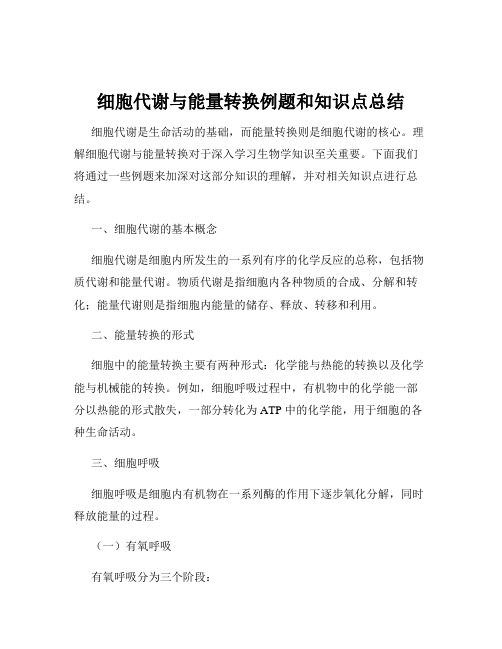
细胞代谢与能量转换例题和知识点总结细胞代谢是生命活动的基础,而能量转换则是细胞代谢的核心。
理解细胞代谢与能量转换对于深入学习生物学知识至关重要。
下面我们将通过一些例题来加深对这部分知识的理解,并对相关知识点进行总结。
一、细胞代谢的基本概念细胞代谢是细胞内所发生的一系列有序的化学反应的总称,包括物质代谢和能量代谢。
物质代谢是指细胞内各种物质的合成、分解和转化;能量代谢则是指细胞内能量的储存、释放、转移和利用。
二、能量转换的形式细胞中的能量转换主要有两种形式:化学能与热能的转换以及化学能与机械能的转换。
例如,细胞呼吸过程中,有机物中的化学能一部分以热能的形式散失,一部分转化为 ATP 中的化学能,用于细胞的各种生命活动。
三、细胞呼吸细胞呼吸是细胞内有机物在一系列酶的作用下逐步氧化分解,同时释放能量的过程。
(一)有氧呼吸有氧呼吸分为三个阶段:第一阶段:在细胞质基质中,葡萄糖分解为丙酮酸和少量H,释放少量能量。
例题:在有氧呼吸的第一阶段,1 分子葡萄糖分解产生的能量大约为多少?答案:2 个 ATP 分子的能量。
第二阶段:在线粒体基质中,丙酮酸和水彻底分解为二氧化碳和H,释放少量能量。
第三阶段:在线粒体内膜上,H与氧结合生成水,释放大量能量。
例题:有氧呼吸第三阶段产生的能量最多,这是因为什么?答案:因为此阶段H和氧的结合是一个放能过程,而且氧气作为电子受体使得电子传递链产生的能量能够大量积累。
(二)无氧呼吸无氧呼吸分为两种类型:酒精发酵和乳酸发酵。
酒精发酵:在细胞质基质中,葡萄糖分解为酒精和二氧化碳,释放少量能量。
乳酸发酵:在细胞质基质中,葡萄糖分解为乳酸,释放少量能量。
四、光合作用光合作用是绿色植物利用光能将二氧化碳和水合成有机物,并释放氧气的过程。
(一)光合作用的过程光合作用分为光反应和暗反应两个阶段。
光反应:在类囊体薄膜上进行,包括水的光解和 ATP 的合成,光能转化为活跃的化学能。
例题:光反应阶段产生的氧气来自于哪里?答案:水的光解。
细胞的代谢与能量转换

细胞的代谢与能量转换细胞是生物体的基本单位,它们通过代谢和能量转换维持着生命的正常运行。
细胞代谢是一系列化学反应的总称,它包括合成(合成代谢)和分解(分解代谢)两个过程。
能量转换则指的是细胞如何将外界的能量转化为化学能,从而为细胞内的活动提供动力。
1. 细胞代谢细胞代谢是维持细胞生命的基础过程,它涉及到多种物质的合成和分解。
细胞通过代谢合成细胞器官、细胞结构和细胞分裂所需的物质,同时也通过分解代谢来获得能量。
细胞代谢包括两个主要类型:异养代谢和自养代谢。
异养代谢指的是细胞从外界环境中摄取有机物质作为能量和碳源,然后将这些有机物质降解为简单物质以释放能量,并合成细胞所需的物质。
自养代谢则指的是细胞通过光合作用或化学合成途径从无机物质中获得能量和碳源,合成有机物质。
2. 能量转换能量是细胞活动的驱动力,细胞能够将外界的能量转化为化学能,以供细胞内各种生化反应进行。
细胞内的能量转换主要通过三种途径实现:细胞色素系统、细胞呼吸和发酵。
细胞色素系统是一种将光能转化为化学能的过程,它存在于植物和一些细菌的叶绿体和细菌色素体中。
这一过程通过光合作用中的光合色素分子吸收光能,将光能转化为化学能,并将其储存在ATP和NADPH分子中。
这些储存的化学能可以供细胞在光合作用后的其他生化反应中使用。
细胞呼吸是一种通过氧化代谢有机物质来释放能量的过程,它在细胞的线粒体内进行。
细胞呼吸包括三个主要阶段:糖酵解、三羧酸循环和氧化磷酸化。
糖酵解将葡萄糖分解为丙酮酸和乙酸等物质,并产生少量的ATP和NADH。
三羧酸循环将丙酮酸和乙酸等物质进一步氧化,释放更多的ATP和NADH。
氧化磷酸化是细胞呼吸过程中产生最多ATP的阶段,它通过将NADH和FADH2中的电子传递到呼吸链上的细胞色素和辅酶Q来驱动ATP的合成。
发酵是一种在没有氧气的条件下通过有机物质进行能量转换的过程。
细胞通过发酵过程来产生少量的能量和维持细胞的生活活动。
常见的发酵过程包括乳酸发酵和酒精发酵等。
《细胞的能量转换器》课件
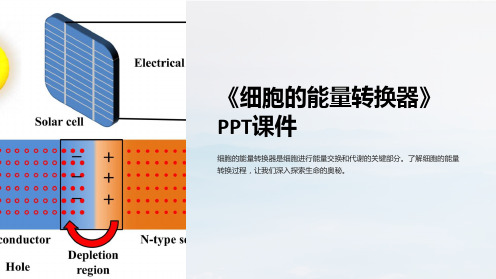
氧气
2
在有氧呼吸中起到氧化剂的作用。
3
酶
催化细胞内各种化学反应。
能量转换器与细胞的生存关系
正常细胞 能量转换过程受阻
能量转换器正常工作,细胞功能正常。 细胞功能受损,可能引发细胞死亡。
细胞能量转换与人类应用
生物能源生产利用微生物和植物 Nhomakorabea能量转换能 力,开发绿色能源。
代谢性疾病研究
研究细胞能量转换异常与疾病的 关系,开发治疗方法。
《细胞的能量转换器》 PPT课件
细胞的能量转换器是细胞进行能量交换和代谢的关键部分。了解细胞的能量 转换过程,让我们深入探索生命的奥秘。
细胞的能量转换过程
有氧呼吸
通过线粒体进行,产生大量ATP。
乳酸发酵
在无氧条件下进行,产生乳酸和 少量ATP。
苏氨酸发酵
只在某些微生物中进行,产生苏 氨酸和少量ATP。
细胞是生命体中的基本单位
复杂组织
构成器官和生物体。
自主功能
能进行新陈代谢、生长和分裂。
基因信息
负责传递和维持遗传信息。
细胞能量转换的重要性
1 生物体能量供应
维持生命活动的必需。
2 物质转化
3 信息传递
提供建设细胞物质的能量。
调控细胞内各种代谢反应。
细胞能量转换涉及的物质
1
有机物
如葡萄糖、脂肪酸等。
运动表现提升
优化能量转换过程,提高运动员 的体能表现。
探索细胞的谜团
新的能量转化方式
是否还存在其他未知的能量转换方式?
进化与适应
不同生物体的能量转换机制如何适应环境?
疾病与能量转换
能量转换异常如何导致疾病的发生和发展?
细胞生物学中的细胞代谢和能量转换

细胞生物学中的细胞代谢和能量转换细胞代谢和能量转换是细胞生物学中重要的研究领域。
细胞代谢是指细胞内化学反应的总和,涵盖了各种生物分子的合成和降解过程。
而能量转换则是细胞在代谢过程中能量的利用和转化。
一、细胞代谢细胞代谢可分为两个主要方面:合成代谢和降解代谢。
1. 合成代谢:合成代谢是指细胞内新分子的合成过程。
在合成代谢中,细胞利用外界提供的原料分子,通过一系列化学反应,合成各种生物分子,如蛋白质、核酸、脂质和多糖等,以满足细胞结构和功能的需要。
2. 降解代谢:降解代谢是指细胞内生物分子的降解过程。
在降解代谢中,细胞分解各种生物分子,如蛋白质、核酸和脂质等,以释放能量和废物产物。
这个过程也被称为有氧或无氧呼吸。
二、能量转换能量转换是细胞代谢中的关键过程,主要指细胞内能量的利用和转化。
1. 能量的来源:细胞内能量的主要来源是葡萄糖分子。
通过细胞呼吸过程,葡萄糖分子被降解释放出大量的能量,并合成三磷酸腺苷(ATP),供细胞使用。
2. ATP的生成:ATP是细胞内的能量储存和转化分子。
它通过细胞内呼吸链和光合作用中的化学反应生成。
在细胞内呼吸过程中,葡萄糖分子被氧化,释放出能量,最终生成ATP。
而在光合作用中,光能被转化为化学能,最终也生成ATP。
3. 能量的利用:细胞内的能量转换主要通过ATP分子的形成和分解来实现。
细胞在需要能量时,ATP分子被分解为较低能量的化合物,释放出能量供细胞反应使用。
反之,当细胞合成和储存能量时,ATP分子的形成和储存将被优先进行。
三、细胞代谢与能量转换的调控细胞代谢和能量转换的过程需要受到严格的调控,以适应细胞内外环境的变化。
1. 酶的调控:细胞代谢和能量转换所涉及的化学反应需要依靠酶来促进。
酶的活性和产量受到多种调控因子的影响,如底物浓度、pH值、温度和激素等。
2. 能量调控:细胞能量转换过程中所生成的ATP分子能够反馈抑制相关的代谢酶,从而调节能量的产生和消耗。
当细胞内ATP浓度高时,能量合成途径将减慢,而能量消耗途径将增加,以维持细胞内能量平衡。
细胞代谢与能量转换

细胞代谢与能量转换细胞代谢是细胞内发生的一系列生化反应,主要涉及能量的产生和利用。
其中,能量转换是细胞代谢的重要过程之一。
本文将从细胞的能量需求、能量转换的机制以及调节因子等方面,探讨细胞代谢与能量转换的关系。
一、细胞的能量需求细胞是生命的基本单位,其正常运作需要大量的能量。
细胞能量需求的主要来源是细胞内的代谢活动,特别是细胞呼吸过程中产生的能量。
这些能量主要用于维持细胞结构的稳定、细胞活动的正常进行以及物质的合成和降解等。
二、能量转换的机制能量转换是指将外界供给的能量转化为细胞内能量形式的过程。
而这一过程主要通过三大生物分子来完成:葡萄糖、脂肪和蛋白质。
1. 葡萄糖代谢葡萄糖是细胞内最主要的能量源之一,它可以通过糖酵解和细胞呼吸两个途径进行代谢。
在糖酵解中,葡萄糖被分解为乳酸,并释放少量的能量。
而在细胞呼吸中,葡萄糖在线粒体内被氧化为二氧化碳和水,同时释放出大量的能量。
这一过程包括三个步骤:糖解、丙酮酸循环和氧化磷酸化。
通过氧化磷酸化,细胞可以获得最高能量产量。
2. 脂肪代谢脂肪是储存能量的重要物质,一旦体内的葡萄糖储备不足,细胞将转而利用脂肪来产生能量。
脂肪酸被氧化为乙酰辅酶A,进入丙酮酸循环并通过氧化磷酸化途径产生ATP。
3. 蛋白质代谢蛋白质是构成细胞的重要组成成分,但在能量产生过程中很少直接参与。
在细胞代谢中,蛋白质主要被分解为氨基酸,其中一部分可以通过转氨基作用后参与糖酵解和丙酮酸循环进而产生能量。
三、调节因子细胞代谢与能量转换的过程受到多个调节因子的控制。
其中,最重要的调节因子是ATP和AMP的比例。
当细胞内ATP水平高时,会抑制细胞中的酶活性,从而减少葡萄糖和脂肪的分解以及蛋白质的合成;而当ATP水平低于一定值时,AMP的浓度升高,进一步刺激酶活性,促进能量转换的进行。
另外,还有激素如胰岛素和肾上腺素等对细胞代谢和能量转换起到重要作用。
胰岛素可以促进葡萄糖的摄取、利用和储存,使细胞内的能量转换向合成方向发展;而肾上腺素则促进葡萄糖的分解,提高细胞内能量产量。
能量转换在细胞生物学中的作用

能量转换在细胞生物学中的作用能量转换是指将一种形式的能量转化为另一种形式的能力。
在细胞生物学中,能量转换是非常重要的一个过程。
生物体需要能量来维持自身的生命活动,而细胞则是生物体中能量转换的重要场所。
在细胞中,能量转换涉及到多种化学反应和多个细胞器的协同作用,下面将介绍细胞内能量转换的过程,并探讨其在生命活动中的重要性。
1. ATP能量循环ATP是细胞内能量转换的重要媒介。
ATP能量循环是指将食物中的化学能转化为ATP,再利用ATP的化学能驱动细胞内的化学反应和物质输运。
在能量循环中,葡萄糖分子通过吸收外界能量,在细胞质中经过一系列酶的催化反应分解为丙酮酸和磷酸酸化物。
丙酮酸进入线粒体内,经过三个酶的反应最终转化为乙酰辅酶A,然后通过Krebs循环进一步分解产生ATP。
在线粒体内,电子从NADH和FADH2向氧气流转,形成H+离子和水,释放出能量,这些能量被利用来合成ATP。
在细胞质中,通过糖异生途径将丙酮酸的代谢产物重新合成为葡萄糖,进入ATP能量循环。
2. 精细调节能量转换能量的转换需要进行精细的调节。
细胞中有多种酶和蛋白质参与能量转换过程,如ATP合成酶、碳酸酐酶、红细胞素、异恶唑核苷酸等。
这些蛋白质通过担任催化剂或结合ATP分子来促进ATP的生成和水解。
此外,还有一些调节因子通过调节酶的活性来精细调节ATP产生的速率。
例如,腺苷酸酰化酶可降低ATP酶的协同作用,降低ATP的转化率。
3. 能量转换与细胞代谢能量转换还与细胞代谢密切相关。
在细胞中,代谢过程分为半乳糖和葡萄糖两个通路,这两个通路共享同一种ATP能量循环,半乳糖代谢过程通过如fruK和hexA等特定酶的作用促进ATP的产生。
此外,ATP能量循环还可以通过糖异生作用来产生胆固醇和脂肪酸等重要分子,进一步参与细胞代谢。
4. 能量转换的意义能量转换在细胞生物学中的意义非常重要。
细胞依赖能量来维持生命活动,从葡萄糖的代谢到氧的吸入始终需要能量转换的支持。
细胞的电子传递链与能量转换

细胞的电子传递链与能量转换细胞是生命的基本单位,其中发生着无数复杂的化学反应和能量转换过程。
而细胞内的电子传递链则是能量转换的关键环节之一。
本文将介绍细胞的电子传递链以及它在能量转换中的重要作用。
一、细胞的能量转换细胞需要能量来维持正常的生命活动,比如合成物质、维持细胞膜的稳定、运输物质等。
而这些能量来自于食物中的有机物质的氧化过程。
细胞通过一系列的化学反应将有机物质中的化学能转化为细胞内的化学能或者高能化合物,如三磷酸腺苷(ATP)等。
二、细胞膜上的电子传递链细胞膜是细胞内外环境隔离的关键结构之一。
细胞膜上存在着一系列的蛋白质复合物,它们构成了电子传递链。
这些复合物通过转运电子来实现能量转换的过程。
首先,电子来自于有机物质的氧化过程。
在细胞质中,有机物质被降解为较小的分子,同时释放出电子,这些电子被载体分子捕获。
然后,这些载体分子将电子传递给电子传递链上的第一个复合物。
在传递过程中,电子中的能量逐渐降低,同时释放出的能量被利用来推动质子(H+)泵入膜间隙。
这个过程称为质子泵。
接下来,电子在电子传递链中依次传递给下一个复合物。
在每个复合物的过程中,电子的能量再次降低,同时释放出的能量继续用于推动质子泵。
最后,电子传递链上的最终复合物将电子传递给能量接收体。
能量接收体将电子与氧气结合,形成水分子。
三、细胞内能量转换过程在细胞膜上的电子传递链中,质子泵将质子泵入膜间隙,使得膜内侧相对富集了质子。
这种质子梯度产生了一种被称为质子动力学的力。
细胞膜酶ATP合酶利用这种质子动力学将磷酸与二磷酸腺苷(ADP)结合,形成ATP。
这就是著名的细胞呼吸过程中的氧化磷酸化反应。
除了产生ATP之外,细胞膜上的电子传递链还可以与其他代谢途径相互作用,产生其他能量转换反应。
比如在光合作用中,光合作用色素系统的电子传递链将能量转移给细胞膜上的复合物,产生光化学反应。
四、细胞的电子传递链与疾病细胞内维持正常的电子传递链对于细胞的生存和功能非常重要。
《生命活动-细胞》细胞代谢:能量转换
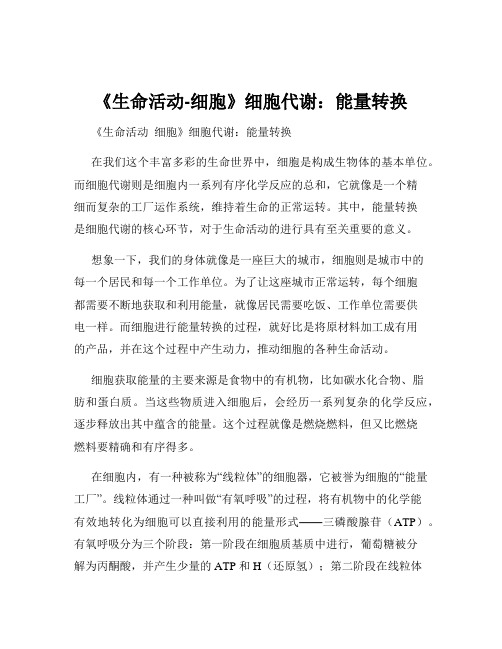
《生命活动-细胞》细胞代谢:能量转换《生命活动细胞》细胞代谢:能量转换在我们这个丰富多彩的生命世界中,细胞是构成生物体的基本单位。
而细胞代谢则是细胞内一系列有序化学反应的总和,它就像是一个精细而复杂的工厂运作系统,维持着生命的正常运转。
其中,能量转换是细胞代谢的核心环节,对于生命活动的进行具有至关重要的意义。
想象一下,我们的身体就像是一座巨大的城市,细胞则是城市中的每一个居民和每一个工作单位。
为了让这座城市正常运转,每个细胞都需要不断地获取和利用能量,就像居民需要吃饭、工作单位需要供电一样。
而细胞进行能量转换的过程,就好比是将原材料加工成有用的产品,并在这个过程中产生动力,推动细胞的各种生命活动。
细胞获取能量的主要来源是食物中的有机物,比如碳水化合物、脂肪和蛋白质。
当这些物质进入细胞后,会经历一系列复杂的化学反应,逐步释放出其中蕴含的能量。
这个过程就像是燃烧燃料,但又比燃烧燃料要精确和有序得多。
在细胞内,有一种被称为“线粒体”的细胞器,它被誉为细胞的“能量工厂”。
线粒体通过一种叫做“有氧呼吸”的过程,将有机物中的化学能有效地转化为细胞可以直接利用的能量形式——三磷酸腺苷(ATP)。
有氧呼吸分为三个阶段:第一阶段在细胞质基质中进行,葡萄糖被分解为丙酮酸,并产生少量的 ATP 和H(还原氢);第二阶段在线粒体基质中进行,丙酮酸和水进一步反应,生成二氧化碳和更多的H,同时也产生少量 ATP;第三阶段则在线粒体内膜上进行,H和氧气结合生成水,同时释放出大量的能量,这些能量促使 ADP(二磷酸腺苷)和磷酸结合形成 ATP。
除了有氧呼吸,细胞在缺氧或无氧的条件下,还可以进行无氧呼吸来获取能量。
无氧呼吸的过程相对简单,但产生的能量较少。
比如,在我们进行剧烈运动时,肌肉细胞会因为氧气供应不足而进行无氧呼吸,产生乳酸,这就是为什么运动后我们会感到肌肉酸痛。
ATP 是细胞内能量的“通用货币”。
它就像是我们日常生活中的现金,可以随时被细胞使用。
- 1、下载文档前请自行甄别文档内容的完整性,平台不提供额外的编辑、内容补充、找答案等附加服务。
- 2、"仅部分预览"的文档,不可在线预览部分如存在完整性等问题,可反馈申请退款(可完整预览的文档不适用该条件!)。
- 3、如文档侵犯您的权益,请联系客服反馈,我们会尽快为您处理(人工客服工作时间:9:00-18:30)。
❖ The ATP synthase is a reversible coupling device
❖ Other roles for the proton-motive force in addition to ATP synthase
F1: 5 subunits in the ratio 3:3:1:1:1
F0: 1a:2b:12c
❖F1 particles have ATP synthase activity
❖ Proton translocation through F0 drives ATP synthesis by F1: Binding Change Model and rotational catalysis
Electron transport Oxidative phosphorylation Metabolite transport
Maห้องสมุดไป่ตู้rix
Intermembrane space
Pyruvate oxidation TCA cycle ßoxidation of fats
Nucleotide phosphorylation
B. Molecular basis of phosphorylation: ATP synthase
❖ The structure of the ATP synthase
F1 particle is the catalytic subunit; The F0 particle attaches to F1 and is embedded in the inner membrane.
三羧酸循环:底物水平的磷酸化产生(线粒体)2ATP; 产生 6NADH(线粒体),生成 18ATP; 产生 2FADH2(线粒体),生成 4 ATP
总计生成 36或38 ATP
3. Chloroplast and photosynthesis
A. Comparison of a mitochondrion and a chloroplast.
As electrons move through the electron-transport chain, H+ are pumped out across the inner membrane, and form Proton motive force;
Electrons move through the inner membrane via a series of carriers of decreasing redox potential
More than 21026 molecules (>160kg) of ATP per day in our bodies.
Electrons pass from NADH or FADH2 to O2, the terminal electron acceptor, through a chain of carriers in the inner membrane (FMN, Fe-S center, Heme group Fe, CoQ);
Chapter 7
Energy Generation in Mitochondria and Chloroplasts
(1) Mitochondria: in all eukaryotic cells The relationship between the structure and function of mit.
DNA replication, RNA transcription,
Protein translation
2. Molecular basis of oxidative phosphorylation
A. Molecular basis of oxidation: Electrontransport chain
生物氧化产生ATP的统计
一个葡萄糖分子经过细胞呼吸全过程产生多少ATP?
糖酵解:底物水平磷酸化产生 4 ATP(细胞质) 己糖分子活化消耗 2 ATP(细胞质) 产生 2NADH,经电子传递产生 4或 6 ATP
(线粒体)净积累 6或8 ATP
丙酮酸氧化脱羧:产生 2NADH(线粒体),生成 6ATP
Figure 7-26 An experiment demonstrating that the ATP synthase is driven by proton flow. By combining a lightdriven bacterial proton pump (bacteriorhodopsin), an ATP synthase purified from ox heart mitochondria, and phospholipids, vesicles were produced that synthesized ATP in response to light.
Figure 14-6 Fractionation of purified mitochondria into separate components. These techniques have made
it possible to study the different proteins in each mitochondrial compartment. The method shown, which allows the processing of large numbers of mitochondria at the same time, takes advantage of the fact that in media of low osmotic strength water flows into mitochondria and greatly expands the matrix space (yellow). While the cristae of the inner membrane allow it to unfold to accommodate the expansion, the outer membranewhich has no folds to begin withbreaks, releasing a structure composed of only the inner membrane and the matrix.
Figure 7-4 Relationship between mitochondria and microtubules.
Figure 7-3 Mitochondrial plasticity. Rapid changes of shape are observed when a mitochondrion is visualized in a living cell.
Localization of metabolic functions within the mitochondrion
Outer membrane:
Phospholipid synthesis fatty acid desaturation Fatty acid elongation
Inner membrane:
Figure 7-5 Localization of mitochondria near sites of high ATP utilization in cardiac muscle and a sperm tail.
❖Inner and outer mitochondrial membranes enclose two spaces: the matrix and intermembrane space.
C. Mithchell’s Chemiosmotic theory (1961)
❖The pH and electrical gradient resulting from transport of protons links oxidation to phosphorylation. ❖When electrons are passed to carriers only able to accept electrons, the H+ is translocated across the inner membrane.
(1) Electron-transport chain: Carry out oxidation reactions; (2) ATP synthase: Makes ATP in the matrix; (3) Transport proteins: Allow the passage of metabolites
1. Mitochondria and oxidative phosphorylation A. Mitochondrial structure and function
❖The size and number of mitochondria reflect the energy requirements of the cell.
Figure 14-39 The chloroplast. This photosynthetic organelle contains three
distinct membranes (the outer membrane, the inner membrane, and the thylakoid membrane) that define three separate internal compartments (the intermembrane space, the stroma, and the thylakoid space). The thylakoid membrane contains all of the energy-generating systems of the chloroplast. In electron micrographs this membrane appears to be broken up into separate units that enclose individual flattened vesicles (see Figure 14-40), but these are probably joined into a single, highly folded membrane in each chloroplast. As indicated, the individual thylakoids are interconnected, and they tend to stack to form aggregates called grana.
